Answered step by step
Verified Expert Solution
Question
1 Approved Answer
MAP 2.4 Tesco Locations and Its Cross-Cultural Project The orange-colored countries on the map show Tesco's operations by country as of 2015.The arrows indicate
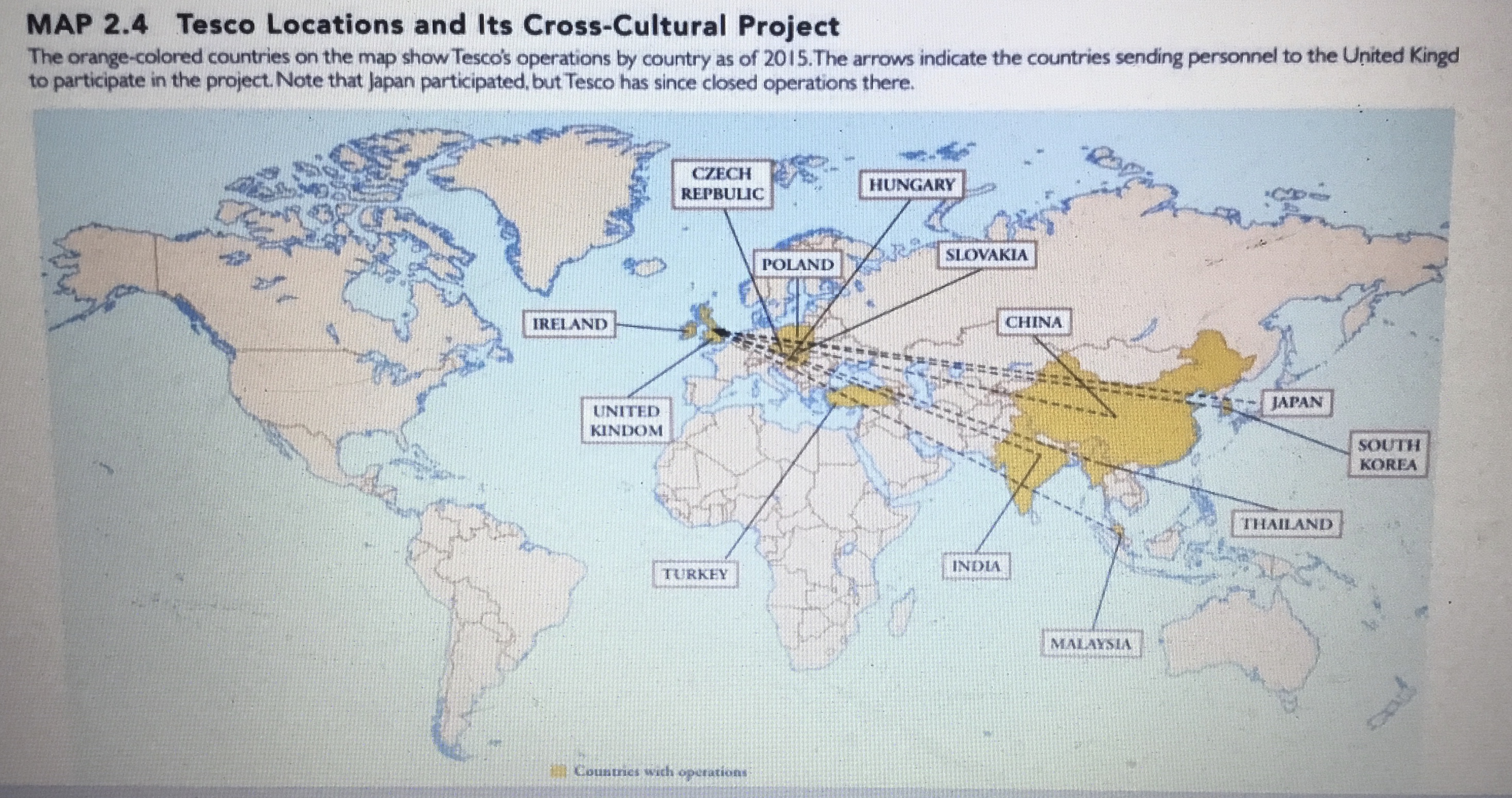

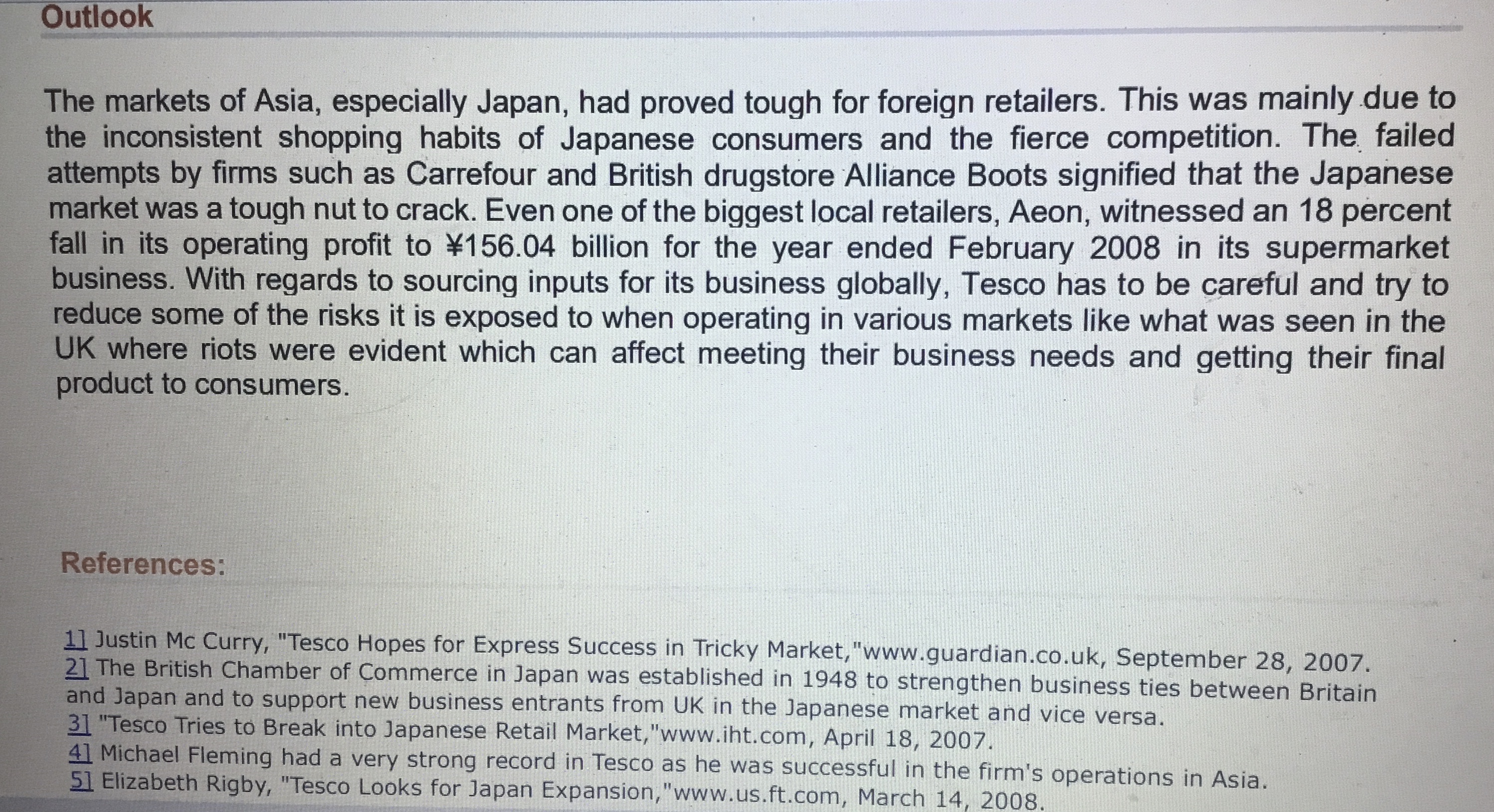
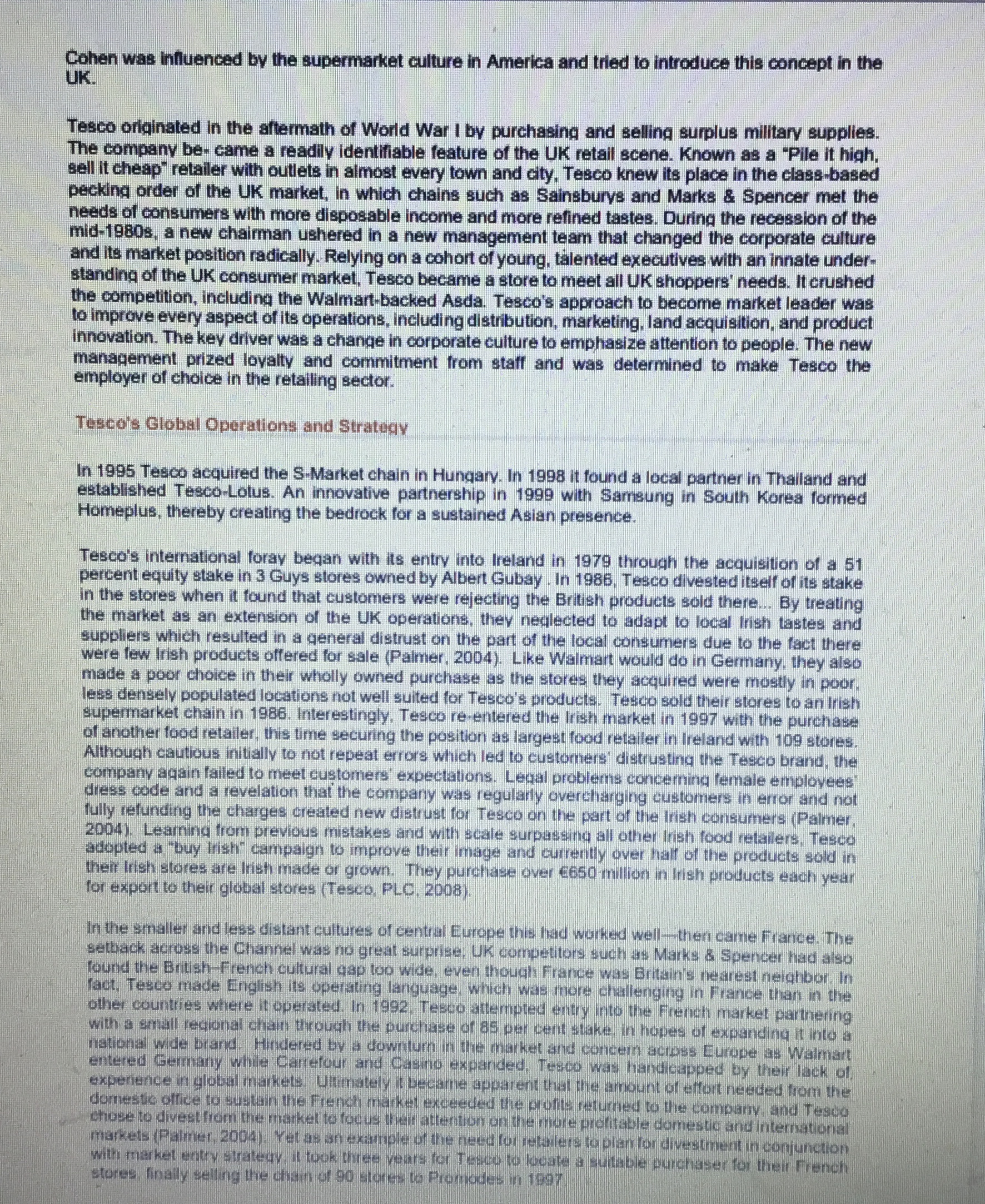
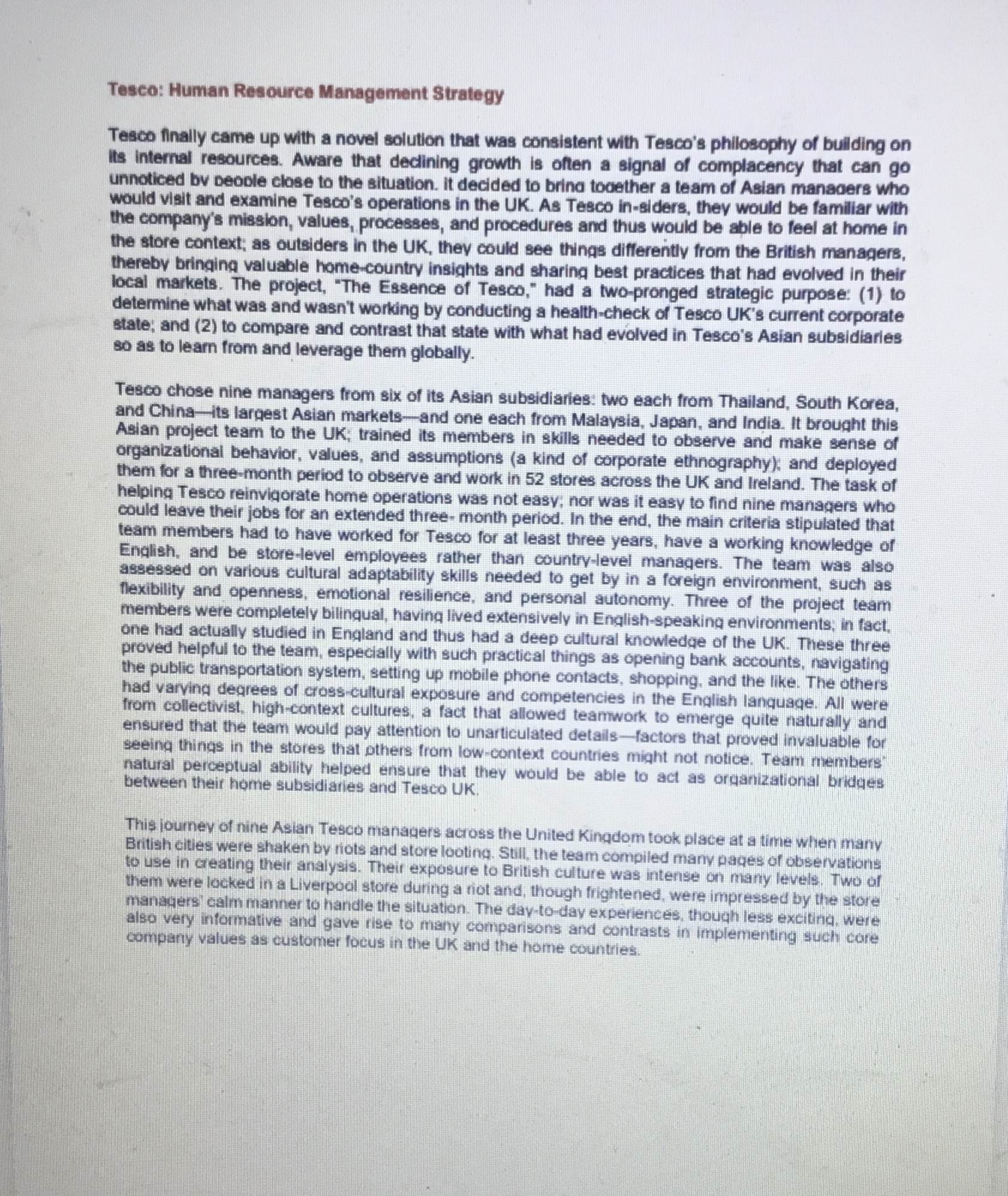
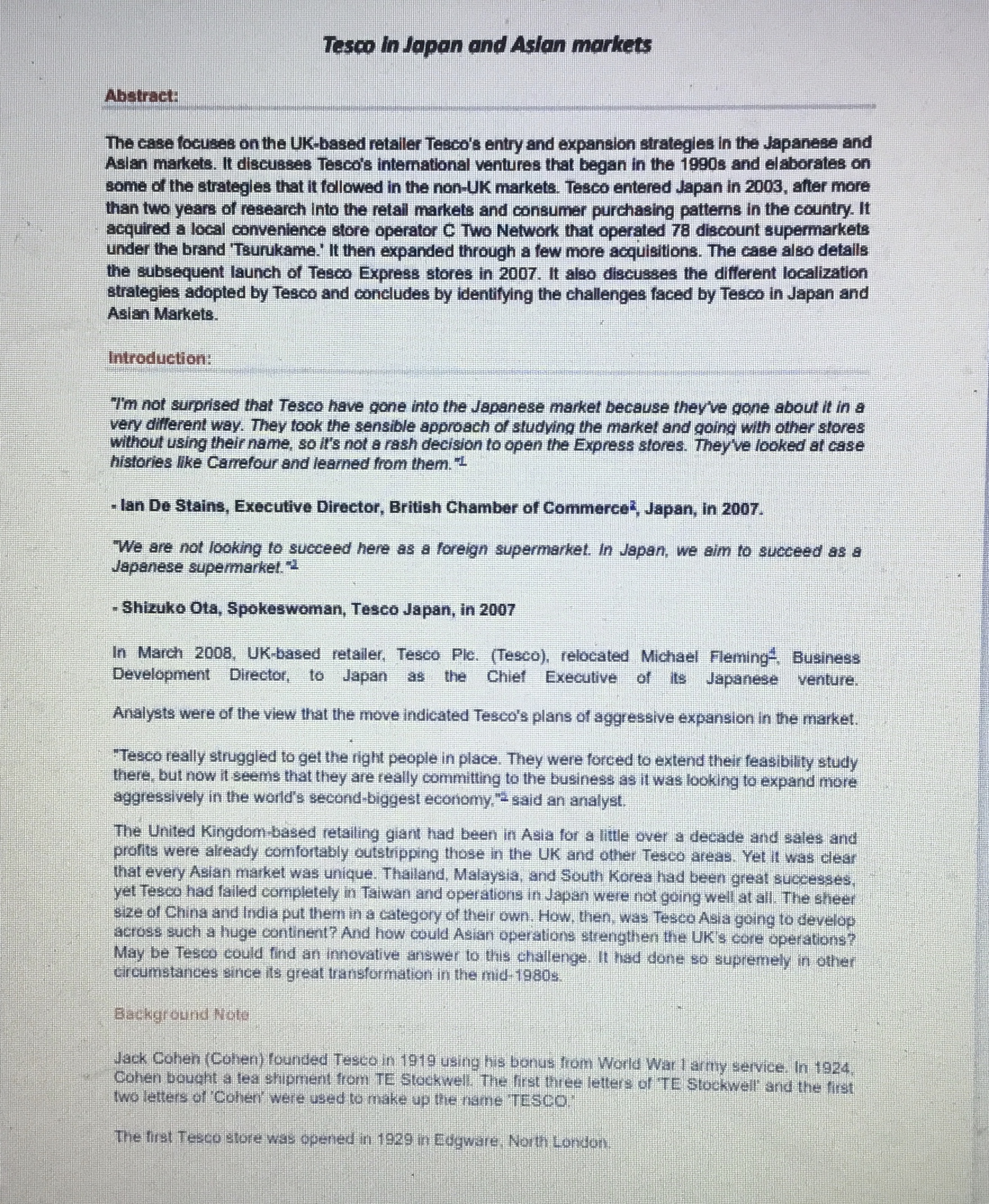
MAP 2.4 Tesco Locations and Its Cross-Cultural Project The orange-colored countries on the map show Tesco's operations by country as of 2015.The arrows indicate the countries sending personnel to the United Kingd to participate in the project. Note that Japan participated, but Tesco has since closed operations there. IRELAND UNITED KINDOM CZECH REPBULIC POLAND HUNGARY SLOVAKIA INDIA TURKEY Countries with operations CHINA MALAYSIA JAPAN SOUTH KOREA THAILAND Tesco's Entry into Japan Tesco's first Asian venture was in Thailand in 1998 through a joint venture with the Lotus chain. As it got a good response in Thailand, Tesco decided to expand into other Asian countries, and sensed an opportunity in the Japanese market. Japan was the world's second biggest retail market. There were several opportunities available for companies which provided products and services that offered quality. style, luxury, and convenience. It had a well-developed consumer base with high amounts of disposable income. In order to further strengthen its foothold and expand its presence in the Japanese market, Tesco went on to acquire a few more retailers which were not performing well in the market. In April 2004, it acquired Fre'c (Fresh and Cost), located in Chiba and Saitama. The company was not doing well and had an outstanding debt of 10 billion. As part of the acquisition, 3 billion of Fre'c's debt was paid by C Two-Network. Localization Strategies in Japan The look and feel of Tesco Express stores in Japan was very local and the stores were designed keeping in mind the Japanese mentality. They were located in central areas within the city as the Japanese did not like to travel long distances for shopping. The French and Taiwanese experiences taught Tesco a strong lesson about foreign market entry strategy. Determined to banish any signs of imperialism and restore the qualities of hard work, humility, and customer dedication in future ventures, the company moved toward a more locally responsive stance. Tesco: Strategic Drivers and Risks Tesco group identified six strategic drivers to become a stronger brand and relevant to the shoppers. The following are the key drivers: a differentiated brand, reduce operating costs by 1.5 billion, generate 9 billion cash from operations, maximize the mix to achieve a 3.5-4.0% margin, maximize value from the property, and innovation (Tesco. 2018). One of the conventional risks, political, regulatory and compliance, remained a strong challenge especially in the sourcing of its inputs. Most of the markets were becoming stricter on requlatory compliance for foreign investors. Therefore, global operations needed to quard against anticipated political and requlatory changes which had the potential to affect Tesco's inputs and consequently their bottom line. Although the company had accumulated a vast working knowledge of international business as Tesco rapidly became the world's third-largest food retailer, it faced questions. How could it go about managing flourishing growth in Asia while maintaining and even enhancing the competitive position of Tesco in the UK? Was there a way to transfer Tesco's leading edge data, purchasing, sourcing and distribution of resources/inputs across its global operations while also learning from the best practices evolving from operations in its foreign subsidiaries? Japan, the world's third-biggest grocery market, remains a difficult country to make money from as international retailers Walmart and Carrefour have found out. Walmart has not done great in Japan with its presence since 2002 through Seiyu. When Carrefour had entered Japan in 2000, it had made huge claims on revolutionizing retailing in the country. However, in 2005. Carrefour swapped its Japanese assets for Tesco's assets in Taiwan. In September 2011. Tesco, the British supermarket group and the world's third-biggest retailer announced its exit from Japan after 8 years in the country. in the event. Tesco became the latest in a long list of foreign retailers to exit from Japan. Seven & 1 Holdings and Aeon dominate Japan. Even British drugstore chain Boots pulled out of Japan owing to increased competition and deflation. Additionally, Japan's Byzantine distribution system of closely knit web of suppliers and consumers' fickle taste is the reason behind many retailers struggling Many analysts attribute the failure to misreading Japanese consumers mindset. However the competitive Japanese retail market is a tough arena, not just for foreign retailers but also for local Japanese department stores Local stores also have been struggling with price deflation and ever- increasing specialty stores Outlook The markets of Asia, especially Japan, had proved tough for foreign retailers. This was mainly due to the inconsistent shopping habits of Japanese consumers and the fierce competition. The failed attempts by firms such as Carrefour and British drugstore Alliance Boots signified that the Japanese market was a tough nut to crack. Even one of the biggest local retailers, Aeon, witnessed an 18 percent fall in its operating profit to 156.04 billion for the year ended February 2008 in its supermarket business. With regards to sourcing inputs for its business globally, Tesco has to be careful and try to reduce some of the risks it is exposed to when operating in various markets like what was seen in the UK where riots were evident which can affect meeting their business needs and getting their final product to consumers. References: 1] Justin Mc Curry, "Tesco Hopes for Express Success in Tricky Market, "www.guardian.co.uk, September 28, 2007. 2] The British Chamber of Commerce in Japan was established in 1948 to strengthen business ties between Britain and Japan and to support new business entrants from UK in the Japanese market and vice versa. 3] "Tesco Tries to Break into Japanese Retail Market,"www.iht.com, April 18, 2007. 4] Michael Fleming had a very strong record in Tesco as he was successful in the firm's operations in Asia. 51 Elizabeth Rigby, "Tesco Looks for Japan Expansion,"www.us.ft.com, March 14, 2008. Cohen was influenced by the supermarket culture in America and tried to introduce this concept in the UK. Tesco originated in the aftermath of World War I by purchasing and selling surplus military supplies. The company became a readily identifiable feature of the UK retail scene. Known as a "Pile it high. sell it cheap" retailer with outlets in almost every town and city, Tesco knew its place in the class-based pecking order of the UK market, in which chains such as Sainsburys and Marks & Spencer met the needs of consumers with more disposable income and more refined tastes. During the recession of the mid-1980s, a new chairman ushered in a new management team that changed the corporate culture and its market position radically. Relying on a cohort of young, talented executives with an innate under- standing of the UK consumer market, Tesco became a store to meet all UK shoppers' needs. It crushed the competition, including the Walmart-backed Asda. Tesco's approach to become market leader was to improve every aspect of its operations, including distribution, marketing, land acquisition, and product innovation. The key driver was a change in corporate culture to emphasize attention to people. The new management prized loyalty and commitment from staff and was determined to make Tesco the employer of choice in the retailing sector. Tesco's Global Operations and Strategy In 1995 Tesco acquired the S-Market chain in Hungary. In 1998 it found a local partner in Thailand and established Tesco-Lotus. An innovative partnership in 1999 with Samsung in South Korea formed Homeplus, thereby creating the bedrock for a sustained Asian presence. Tesco's international foray began with its entry into Ireland in 1979 through the acquisition of percent equity stake in 3 Guys stores owned by Albert Gubay. In 1986, Tesco divested itself of its stake in the stores when it found that customers were rejecting the British products sold there... By treating the market as an extension of the UK operations, they neglected to adapt to local Irish tastes and suppliers which resulted in a general distrust on the part of the local consumers due to the fact there were few Irish products offered for sale (Palmer, 2004). Like Walmart would do in Germany, they also made a poor choice in their wholly owned purchase as the stores they acquired were mostly in poor. less densely populated locations not well suited for Tesco's products. Tesco sold their stores to an Irish supermarket chain in 1986. Interestingly. Tesco re-entered the Irish market in 1997 with the purchase of another food retailer, this time securing the position as largest food retailer in Ireland with 109 stores. Although cautious initially to not repeat errors which led to customers' distrusting the Tesco brand, the company again failed to meet customers' expectations. Legal problems concerning female employees dress code and a revelation that the company was regularly overcharging customers in error and not fully refunding the charges created new distrust for Tesco on the part of the Irish consumers (Palmer, 2004). Learning from previous mistakes and with scale surpassing all other Irish food retailers, Tesco adopted a "buy Irish campaign to improve their image and currently over half of the products sold in their Irish stores are Irish made or grown. They purchase over 650 million in Irish products each year for export to their global stores (Tesco, PLC. 2008). In the smaller and less distant cultures of central Europe this had worked well-then came France. The setback across the Channel was no great surprise. UK competitors such as Marks & Spencer had also found the British-French cultural gap too wide, even though France was Britain's nearest neighbor. In fact, Tesco made English its operating language, which was more challenging in France than in the other countries where it operated. In 1992 Tesco attempted entry into the French market partnering with a small regional chain through the purchase of 85 per cent stake in hopes of expanding it into a national wide brand. Hindered by a downturn in the market and concern across Europe as Walmart entered Germany while Carrefour and Casino expanded. Tesco was handicapped by their lack of experience in global markets Ultimately it became apparent that the amount of effort needed from the domestic office to sustain the French market exceeded the profits returned to the company, and Tesco chose to divest from the market to focus the attention on the more profitable domestic and international markets (Palmer, 2004). Yet as an example of the need for retailers to plan for divestment in conjunction with market entry strategy, it took three years for Tesco to locate a suitable purchaser for their French stores, finally selling the chain of 90 stores to Promodes in 1997. Tesco: Human Resource Management Strategy Tesco finally came up with a novel solution that was consistent with Tesco's philosophy of building on its internal resources. Aware that declining growth is often a signal of complacency that can go unnoticed by people close to the situation. it decided to bring together a team of Asian managers who would visit and examine Tesco's operations in the UK. As Tesco in-siders, they would be familiar with the company's mission, values, processes, and procedures and thus would be able to feel at home in the store context; as outsiders in the UK, they could see things differently from the British managers, thereby bringing valuable home-country insights and sharing best practices that had evolved in their local markets. The project, "The Essence of Tesco," had a two-pronged strategic purpose: (1) to determine what was and wasn't working by conducting a health-check of Tesco UK's current corporate state; and (2) to compare and contrast that state with what had evolved in Tesco's Asian subsidiaries so as to learn from and leverage them globally. Tesco chose nine managers from six of its Asian subsidiaries: two each from Thailand, South Korea, and China-its largest Asian markets-and one each from Malaysia, Japan, and India. It brought this Asian project team to the UK; trained its members in skills needed to observe and make sense of organizational behavior, values, and assumptions (a kind of corporate ethnography); and deployed them for a three-month period to observe and work in 52 stores across the UK and Ireland. The task of helping Tesco reinvigorate home operations was not easy, nor was it easy to find nine managers who could leave their jobs for an extended three-month period. In the end, the main criteria stipulated that team members had to have worked for Tesco for at least three years, have a working knowledge of English, and be store-level employees rather than country-level managers. The team was also assessed on various cultural adaptability skills needed to get by in a foreign environment, such as flexibility and openness, emotional resilience, and personal autonomy. Three of the project team members were completely bilingual, having lived extensively in English-speaking environments, in fact, one had actually studied in England and thus had a deep cultural knowledge of the UK. These three proved helpful to the team, especially with such practical things as opening bank accounts, navigating the public transportation system, setting up mobile phone contacts, shopping, and the like. The others had varying degrees of cross-cultural exposure and competencies in the English language. All were from collectivist, high-context cultures, a fact that allowed teamwork to emerge quite naturally and ensured that the team would pay attention to unarticulated details-factors that proved invaluable for seeing things in the stores that others from low-context countries might not notice. Team members natural perceptual ability helped ensure that they would be able to act as organizational bridges between their home subsidiaries and Tesco UK. This journey of nine Asian Tesco managers across the United Kingdom took place at a time when many British cities were shaken by riots and store looting. Still, the team compiled many pages of observations to use in creating their analysis. Their exposure to British culture was intense on many levels. Two of them were locked in a Liverpool store during a riot and, though frightened, were impressed by the store managers' calm manner to handle the situation. The day-to-day experiences, though less exciting, were also very informative and gave rise to many comparisons and contrasts in implementing such core company values as customer focus in the UK and the home countries. Tesco in Japan and Asian markets Abstract: The case focuses on the UK-based retailer Tesco's entry and expansion strategies in the Japanese and Asian markets. It discusses Tesco's international ventures that began in the 1990s and elaborates on some of the strategies that it followed in the non-UK markets. Tesco entered Japan in 2003, after more than two years of research into the retail markets and consumer purchasing patterns in the country. It acquired a local convenience store operator C Two Network that operated 78 discount supermarkets under the brand 'Tsurukame." It then expanded through a few more acquisitions. The case also details the subsequent launch of Tesco Express stores in 2007. It also discusses the different localization strategies adopted by Tesco and concludes by identifying the challenges faced by Tesco in Japan and Asian Markets. Introduction: "I'm not surprised that Tesco have gone into the Japanese market because they've gone about it in a very different way. They took the sensible approach of studying the market and going with other stores without using their name, so it's not a rash decision to open the Express stores. They've looked at case histories like Carrefour and learned from them."L -lan De Stains, Executive Director, British Chamber of Commerce, Japan, in 2007. "We are not looking to succeed here as a foreign supermarket. In Japan, we aim to succeed as a Japanese supermarket." - Shizuko Ota, Spokeswoman, Tesco Japan, in 2007 In March 2008, UK-based retailer, Tesco Plc. (Tesco), relocated Michael Fleming. Business Development Director, to Japan as the Chief Executive of its Japanese venture. Analysts were of the view that the move indicated Tesco's plans of aggressive expansion in the market. "Tesco really struggled to get the right people in place. They were forced to extend their feasibility study there, but now it seems that they are really committing to the business as it was looking to expand more aggressively in the world's second-biggest economy." said an analyst. The United Kingdom-based retailing giant had been in Asia for a little over a decade and sales and profits were already comfortably outstripping those in the UK and other Tesco areas. Yet it was clear that every Asian market was unique. Thailand, Malaysia, and South Korea had been great successes, yet Tesco had failed completely in Taiwan and operations in Japan were not going well at all. The sheer size of China and India put them in a category of their own. How, then, was Tesco Asia going to develop across such a huge continent? And how could Asian operations strengthen the UK's core operations? May be Tesco could find an innovative answer to this challenge. It had done so supremely in other circumstances since its great transformation in the mid-1980s. Background Note Jack Cohen (Cohen) founded Tesco in 1919 using his bonus from World War 1 army service. In 1924. Cohen bought a tea shipment from TE Stockwell. The first three letters of TE Stockwell' and the first two letters of 'Cohen' were used to make up the name TESCO. The first Tesco store was opened in 1929 in Edgware, North London.
Step by Step Solution
There are 3 Steps involved in it
Step: 1

Get Instant Access to Expert-Tailored Solutions
See step-by-step solutions with expert insights and AI powered tools for academic success
Step: 2

Step: 3

Ace Your Homework with AI
Get the answers you need in no time with our AI-driven, step-by-step assistance
Get Started


